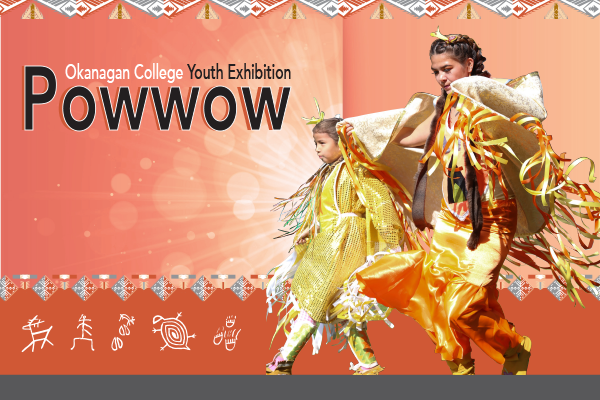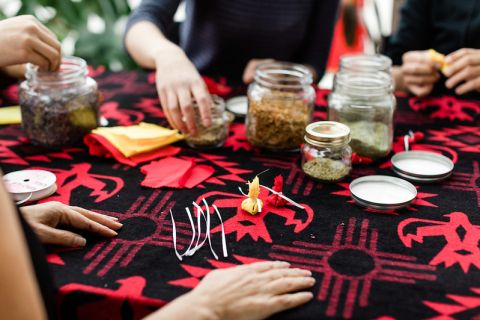Annual Powwow
The Indigenous Services team is excited to announce that the Youth Exhibition Powwow will return in September of 2023! We will update this page with more information as it becomes available. If you have any questions, please email us at Indigenous@okanagan.bc.ca
September 22nd, 2023
9:30 AM GRAND ENTRY
4:00 PM Closing Ceremony
Registration for Vendors is FREE. To sign up please email us at Indigenous@okanagan.bc.ca
Indigenous Services would also like to take this opportunity to mention Orange Shirt Day is September 30, 2022. Please wear an orange shirt to acknowledge the harm residential schools have caused, the healing that is still occurring with the survivors, and to show commitment to continued reconciliation. Visit https://www.orangeshirtday.org to learn more.

What is a Powwow?
Powwow is a time of gathering and celebration. It is one way that Indigenous peoples maintain and exchange their cultures and heritages. Powwows usually feature song, dance, and an opportunity for people to connect with one another and exchange goods and knowledge.
Powwows likely originated among the Indigenous peoples of the plains, but they have been adapted by many Indigenous peoples and now serve as an opportunity for cultural exchange and celebration of song and dance. Between 1876 and 1951 the Indian Act outlawed cultural practices like powwow in Canada. Despite these restrictions, some Indigenous peoples continued to hold powwows in secret and thereby maintained the tradition. The 1960s saw a resurgence of powwows, which followed the Indigenous rights movement and desire to reclaim cultures that had been forced underground for decades. Modern powwows can be private events only for the local community, or public and open to everyone. They can be traditional, where they are held by local communities and there is no competition, or competitive with dance categories for men, women, and children. They are also a great opportunity for vendors to sell their art, crafts, and food.
Music is the defining feature of a powwow. There are usually three or more drum groups (also called Drums) that perform the music for the event. They will drum and sing, and the song is determined by the purpose of the dance (eg. intertribal, competition dance, flag, healing or honour song). Some powwow songs can be heard at almost every powwow, and some Drums choose to incorporate their own regional songs as well.
Dancing is another key element of powwows. The Circle is the spiritual centre of the event and highly honoured. Powwows both entertain and tell histories through the sacred elements of regalia, dances, and music. Some dances have been adopted by many nations, and some are regionally specific. The intertribal dance is open to everyone, Indigenous and non-Indigenous. Dancers’ unique regalia holds great personal and spiritual significance for them. Regalia can be made from a variety of materials, including beadwork, ribbons, porcupine quills, cotton, buckskin, and feathers. Some common dances at powwows are the men’s Traditional, women’s Traditional, Grass, Fancy, Jingle Dress, and Fancy Shawl.
Powwows are a time to celebrate Indigenous heritages, exchange cultural knowledge, and honour the strength and persistence of those who ensured that these practices would be continued for future generations.
Powwows are organized by committees that work for weeks before the event. At the Powwow, the MC runs the events. The MC works with the Arena Director to keep the Powwow organized and running smoothly. These two individuals work with the committee to bring the people together to dance and fellowship together in the circle.
A powwow session begins with the Grand Entry and, in most cases, a prayer. The Eagle Staff leads the Grand Entry, followed by flags, then the dancers, while one of the host drums sings an opening song. This event is sacred in nature, some powwows do not allow filming or photography during this time, though others allow it. If military veterans or active duty soldiers are present, they often carry the flags and eagle staffs. They are followed by the head dancers, then the remaining dancers usually enter the arena in a specific order: Men's Traditional, Men's Grass Dance, Men's Fancy, Women's Traditional, Women's Jingle, and Women's Fancy. Teens and small children then follow in the same order. Following the Grand Entry, the MC will invite a respected member of the community to give an opening. The host drum that did not sing the Grand Entry song will then sing a Flag Song, followed by a Victory or Veterans' Song, during which the flags and staffs are posted at the MC's table.
Powwow terms
Master of Ceremonies
The master of ceremonies, or MC, is the voice of the powwow. It is his job to keep the singers, dancers, and general public informed as to what is happening. The MC sets the schedule of events, and maintains the drum rotation, or order of when each drum group gets to sing. The MC is also responsible for filling any dead air time that may occur during the powwow, often with jokes. The MC often runs any raffles or other contests that may happen during the powwow.
Arena Director
The arena director is the person in charge during the powwow. Sometimes the arena director is referred to as the whip man, sometimes the whip man is the arena director's assistant, and many powwows don't have a whip man. The arena director makes sure dancers are dancing during the powwow and that the drum groups know what type of song to sing. If there are contests the arena director is ultimately responsible for providing judges, though he often has another assistant who is the head judge. The arena director is also responsible for organizing any ceremonies that may be required during the powwow, such as when an eagle feather is dropped, and others as required. One of the main duties of the arena director is to ensure that the dance arena is treated with the proper respect from visitors to the powwow.
Regalia (re-GAY-lia)
Regalia in Indigenous cultures refers to the traditional and often sacred clothing, accessories and artifacts worn or carried during various ceremonies, such as powwows, celebrations, and pan-national gatherings. The design, type and meaning of regalia varies greatly depending on the individual who wears it, the culture from which it originates and the event where it is worn. Regalia can include woven textiles, jewelry, makeup, footwear, such as moccasins, and accessories, such as headbands, arm bands, breastplates, roaches, shawls, anklets, dance sticks and hackles. (Information from www.thecanadianencyclopedia.ca)
Powwow Etiquette
Here is a little information to help you enjoy the Powwow and to let you know what you can expect, if this is your first time attending.
- Be on time. The committee is doing everything possible to ensure that activities begin and run smoothly. Please cooperate in this regard.
- Master of Ceremonies (MC) is the person who sets the tempo of the powwow.
- Listen to the MC as he will announce the program activities.
- Arena Director is the keeper of the arena circle.
- Respect the traditions of each community. Ask the MC or Arena Director if you are uncertain of any etiquette during the powwow.
- Whipman is the person that ensures that the grounds are respected and the dancers enter into the dance circle in their categories.
- Grand Entry is when all the categories enter the arena circle, led by the flag and eagle staffs, veterans, dignitaries, and powwow royalty.
- Flag song is the First Nation National Anthem - please stand and remove your hat if you don’t have an eagle feather in it to pay your respects.
- Dancers wishing to reserve a space should place a blanket in that space before the dance begins. Please do not sit on someone else’s blanket unless invited. Any uncovered space is not reserved
- Take your own chair, there is usually limited bench seating.
- If taking pictures of the dancers, please ask the dancer first and remember common courtesy and ask permission. Group pictures are usually alright to take.
- Pictures during feather pick-ups is not allowed. Or when a whistle blowing or fanning at the drum is taking place.
- Dance as hard and long as you can in your category or in intertribal dances.
- Be aware of the people behind you who may not be able to see over you – make room, step aside, sit or kneel.
- No alcohol or drugs allowed.
- Princesses and Warriors are the royalty representing their respected powwow community.
- There will be veterans present. They are to be respected. Attendees are welcomed and encouraged to shake their hands.
- Elders are encouraged to have the best seats where they can view the dancing. They should be taken care of, ensure they have assistance, snacks and drinks.
- The MC table is the center head of the arena, not only because it holds a seat for the MC, but it is where the giveaways are arranged and announcements are posted. It is also where the flags and Eagle Staffs are posted and retrieved at the beginning and end of each session.
- Thank you to Richard Jackson Jr. and Ursula R. Drynock for providing the above etiquette.
Bannock and Fry Bread
Bannock or Frybread... The staple of powwows, feasts, special family dinners and roadside stands.
While most cultures around the world have a version of fried dough - sopapillas, beignets, doughnuts... none is so versatile as Indian frybread. Dipped in soup or berry gravy, smothered with honey butter or powdered sugar, or served as an Indian Taco - Bannock or frybread turns into a favorite of all who eat it.
Many Canadians cultures have their traditional bread, usually made from corn or acorn flour. While wheat flour is not indigenous to Native Canadians, since the ration days reservation women have used real "ingenuity" to use foreign ingredients to feed their families. Rations included flour, oil, and yeast or baking powder. The original recipe for Bannock or frybread is not recorded, and was probably created in different areas at the same time.
Recipe
Never Fail Bannock or Frybread
- 4 cups flour
- 2 t. baking powder
- 1 t. salt
- ½ pack fast rising yeast
- 1 teaspoon sugar
- ¼ cup powdered milk
- VERY warm water (out of the tap is fine, hottest water you can still put your finger in)
Mix all dry ingredients, then pour in 1 ½ cups VERY warm water. Stir until incorporated. At this point you'll know if you need to add more water or flour to make a good dough. It should be just slightly sticky. Knead for a minute or two. Cover and let rise for about 1 ½ hours.

